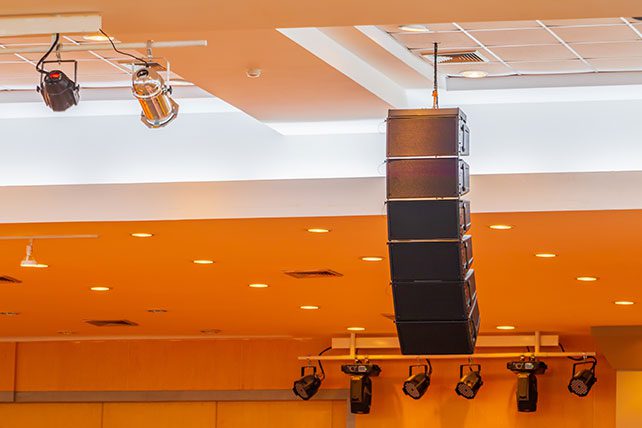Sound panels are available from various acoustical material suppliers and can be obtained in a variety of fabric and finish options to blend with or complement most interior schemes. When the budget can’t afford them, attractive homemade sound panels can be constructed easily using compressed fiberglass (Owens-Corning #703) covered with fabric. For improved low frequency effectiveness, use 2″ thick panels and stand them off the wall a bit, or use thicker material.
Slap echoes are reflections that bounce back and forth between bare parallel walls. They can be easily identified by clapping your hands and listening for ringing. You’ll find, as you clap and move from the middle of the room toward one end, that the slap echo pitch and ring duration will change. This relates to the different round trip distances the sounds travel as they leave your hands, head off in different directions, bounce off the front and back walls, and pass you by.
Some common methods of treating slap echoes are the “live end, dead end” scheme and the “dead end, live end” scheme. Both methods involve treating one end of the listening room, leaving the other end “live” for a natural room ambience.
It is preferable to diffuse slap echoes with diffuser panels. Slap echoes may also be absorbed with carpets, fiberglass panels or drapes. When treating sidewall slap echoes near the sides of the loudspeakers and/or listeners, it is desirable to treat both walls evenly, left and right, to provide a balanced sound field. When treating reflections and echoes, best results are obtained from a proper mix of direct and diffused sound. That is, a balance of diffusive and absorptive materials strategically placed throughout the room. The key in trying and applying all types of room treatments is to utilize test equipment, which is designed to measure the time, energy and frequency relationship with the room. Or you can just listen as you go, use the proper treatment for the identified condition, and experiment, experiment, experiment!
Standing waves are high and low pressure energy buildups, which are determined by frequency and room dimension. They are so named because they do not travel or propagate. Instead, they become anchored at various spots in a room determined by boundary conditions. Although standing waves occur at all audible frequencies in a contained space, our focus will be on the widely spaced, low frequency waves. These low frequency standing waves cause severe peaks and dips in the system’s in-room bass response, creating the dreaded “one-note bass” while obscuring truly deep bass. All rooms except those very large rooms or halls (whose wavelengths are so low in frequency that they can be ignored) have low frequency standing waves of consequence.
You can graphically show which standing wave frequencies will affect a given room by plotting some simple calculations on graph paper. First, calculate the frequency of the lowest fundamental peak (f) for each room dimension (length, width and height, represented by “d”), by dividing 1130 (“v”, or the speed of sound) by twice the dimension in feet, using the formula f = v/2d. The dimension (“d”) is doubled to account for the sound wave’s round trip. Plot your results on separate lines for the room’s length, width and height, one above the other, on your graph paper. Scale the horizontal axis from 20Hz to 150Hz in 10Hz increments. Now plot the additional peaks caused by the even multiples of the fundamental frequency up to 150Hz. For example, if your fundamental standing wave frequency is 50Hz, you will also have buildups at 100Hz and 150Hz. Beyond 150Hz, the spacing of standing waves becomes close enough to ignore. On your graph, any points close to each other will indicate an excessive buildup of energy at that frequency. Ideally, standing waves should be evenly spaced, which will provide a flatter in-room response from most locations. A spreadsheet file on a computer could easily be created to make these church speaker placement calculations and plot your graphs automatically.
In order to determine church speaker placement, after you’ve plotted the graph, play tones to verify your standing wave calculations. Use a sweep tone generator or a test CD recording of a sweep tone, along with your SPL meter or real time analyzer. As you tone sweep from 20Hz to 150Hz, you will notice that the volume from your listening position increases and decreases at different frequencies. Pause the sweep tone at a frequency where the volume is at its loudest from your listening position, then slowly walk around the room. Notice how the volume of the tone changes dramatically as you move around, louder in some areas, barely audible in others. These high and low pressure zones in different positions around the room are standing wave fundamentals and their multiples. These “room modes” are dependent on the room’s dimensions in relation to the frequency of the fundamental and its multiples. Note the standing wave energy distribution.
The sweep tone test is a great way to prove your predictions and observe very real proof of the standing wave phenomenon. Remember to use caution when playing test tones through speakers, as you can easily drivers during this test. If you’re using a tone generator, use only sine waves for testing, not square waves.
Due to the length of low frequency standing waves, they cannot be minimized by applying foam, insulation or carpet to the walls. Typically, fixed bass traps are not practical either, being massive and complicated to build, and portable traps are only minimally effective unless used in large numbers. Now that we know how room dimensions and the fundamental frequencies and their multiples interact, we can position the speakers and listeners to minimize the effects of standing waves. Using our graphs, we can determine the most desirable speaker, subwoofer and/or listener locations, based on the locations of the energy buildups standing waves) from the fundamentals and their multiples corresponding to each room dimension.

